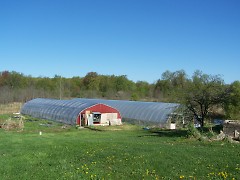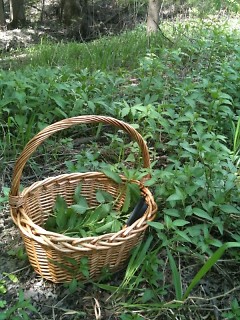Mud Lake Farm: Going Beyond Salad
Situated in between the gentle, sloping hills of the quietude of Hudsonville's farmland - just 20 minutes from Grand Rapids' bustling downtown - is Mud Lake Farm. Mud Lake, a farm that has been in the Van Haitsma family for decades, is increasingly becoming recognized as one of the area's premier salad greens farmers.
“People are recognizing us from the menus of restaurants and they want to know us better – how we farm, what our philosophy is,” says Kris Van Haitsma, owner of Mud Lake with husband, Steve. “Yes, we also have had a great deal of media coverage lately. People have been very interested in getting to know us, and learn how we grow our greens.”
Mud Lake grows over 40 varieties of lettuces throughout the year, using hydroponic techniques and they do not use pesticides. Mud Lake's salad greens are found on restaurant menus throughout Grand Rapids and West Michigan – Salt of the Earth, Electric Cheetah , Winchester - to name a few.
Not only do their greens grace the tables of great restaurants serving local food, but Mud Lake also offers a Community Supported Agriculture program for those who want to receive salad on a regular basis as a “shareholder” of the farm. In addition to these market outlets, the Van Haitsmas are also active as both growers and volunteers of the West Michigan Cooperative.
While most the accolades have gone to the greens in the greenhouses and hydroponic beds, there has been a new addition to the Mud Lake salad bowl – young, tender stinging nettle greens. “We added nettle greens to the most recent ordering cycle of the West Michigan Cooperative. There were seven orders of nettles this cycle.”
Stinging nettles, Utica dioica, is a tall, edible perennial that grows in areas with rich, moist soil along rivers, streams and lakes.** At Mud Lake, the young nettles shoot from the ground in between the cow parsnip in the fields and alongside what Van Haitsma lovingly calls the “barn & garage” project.
Why expand to wild plants beyond the greenhouse? “Our land has rich soil and is filled with an abundance of edible plants - beyond what we cultivate in the hydroponic gardens,” describes Van Haitsma. “It is such a rich ecosystem that it took several years for us to learn what exactly we had growing on our property. Nettles are one of those plants.”
In preparing to harvest and process the nettles, Van Haitsma reminds her customers to wear gloves, referring to the bumps that can come from handling the plant as “ant bites.” The stinging sensation and hive-like bumps that can occur from handling the nettle are caused from the hair-like needles found along its stem and leaves.
Fortunately, the nettles will lose their stinging properties as they dry or are cooked (steamed or sauteed). “I did make sure [our customers] all knew not to touch them raw without gloves unless they liked 'ant bites,'" laughs Kris.
Are nettles the new spinach?
All stinging jokes aside, nettles have great virtues as a wild edible food – it's considered an adaptogen and a good nutritive food for the body. Nettles are very nutrient dense; rich Vitamin C, Vitamin A, calcium, magnesium, zinc, iron, cobalt, copper, potassium, B-complex vitamins – even protein. And they are extremely high in chlorophyll. Look out, spinach.
And speaking of spinach – fresh nettles can easily replace spinach in recipes that call for the greens. They can be lightly cooked and added to soups, egg scrambles, quiches, or other similar recipes.
Nettle leaves can also be dried and stored in glass jars for year-round enjoyment. The dried leaves can be added to soups, or brewed as infusions for drinking. If the infusion is left to sit overnight, the water extracts the beautiful dark greens of the leaves – add a bit of honey to sweeten to taste and it is a refreshing, nourishing beverage.
The wild edible, foraging trend
Is the foodie movement going beyond local, now taking to greens that are relegated to a common ditch weed? “There definitely is more interest now [in foraging wild edibles],” says Van Haitsma. “And we only see it growing.”
While there aren't any local Grand Rapids restaurants serving up nettles on their spring menu, local chefs are slowly adding wild edibles on their menus - some doing the wild crafting for the restaurant themselves. Andrew Voss, head chef at the J.W. Marriott's six.one.six recently described his wild leek foraging adventures for the restaurant on the six.one.six blogspot.
Another farm responding to the trend, Trillium Haven Farm (known most for its large Community Supported Agriculture program) has begun cultivating wild leeks as starter plants for sale. The wild leek transplants will help those wishing to cultivate their own wild leek plot to do so in their home forest gardens.
And though wild edibles might be the up -and-coming culinary trend, Van Haitsma considers the nettle harvests as a novelty for now. “It is great to use what we have on the land, though we are first and foremost trying to meet the salad demands of our restaurants, CSA members, and customers of the West Michigan Co-op.”
But who knows. Maybe this virtuous ditch week will usurp spinach in the coming months....In the meantime, cook up some Nettle Risotto (recipe below), and follow Mud Lake Farm on FaceBook and Twitter, @mudlakefarm.
**Wild edible foragers must take care that when harvesting any plant - not just nettles - to do so in a manner that is sustainable for the plant to ensure over-harvesting. Also be mindful that the source is clean of pesticides and pollution from roadsides. For a great overview of foraging rules to keep at top-of-mind, click here.
Nettle Risotto (recipe adapted by author)
1/4 pound young nettles
12 oz risotto/arborio rice
1 onion, chopped
2 Tablespoons butter
1/2 cup dry white wine (an extra glass for the chef)
6 cups chicken or vegetable stock
1 oz grated Parmesan cheese
1/4 cup Chopped, fresh parsley
Salt, pepper to taste
-
Heat the stock in a large saucepan.
-
Wash the nettle leaves. Blanch for 2 minutes in boiling salted water, drain and chop very finely. Set aside to add at the end.
-
Cook onion gently in half the butter in a large saucepan for a few minutes until tender.
-
Add rice and cook over a slightly higher heat for 2 minutes while stirring. Pour in the wine, deglazing the pan. Cook, uncovered, until all the wine has evaporated, then add about 1 cup boiling hot stock; leave the risotto to cook, stirring occasionally and adding about 1/2 cup boiling stock at intervals as the rice absorbs the liquid.
-
After about 14 - 15 minutes' cooking time the rice will be tender but still have a little 'bite' left in it when tested. Add the prepared nettles and cook for 2-3 minutes, stirring.
-
Take off the heat and stir in the remaining butter which will melt and make the rice look glossy;
- Sprinkle with the freshly grated Parmesan cheese, chopped parsley. Add salt and pepper to taste, stirring gently.
Disclosure: Lisa Rose Starner is a Grand Rapidian and has worked in the area of food and community in Grand Rapids for nearly a decade. This is the first of many food-related articles for her new series in the Rapidian, The Local Beet. An avid gardener and cook, Lisa grows vegetables and herbs with her family on Grand Rapids' West Side. Beyond holding a degree in anthropology and a Masters in Public Administration; Lisa is currently a student of Great Lakes herbalist, Jim McDonald. She is enjoying her newest hyper-local food adventure as a backyard herbalist.
The Rapidian, a program of the 501(c)3 nonprofit Community Media Center, relies on the community’s support to help cover the cost of training reporters and publishing content.
We need your help.
If each of our readers and content creators who values this community platform help support its creation and maintenance, The Rapidian can continue to educate and facilitate a conversation around issues for years to come.
Please support The Rapidian and make a contribution today.



